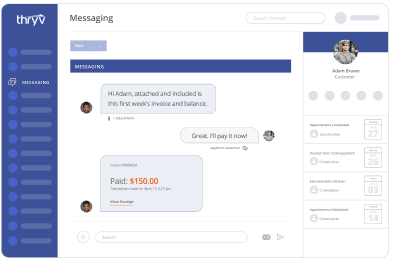Pop quiz: Do you know what ROI means? How about CLV? Or, can you tell me what a marketing-qualified lead is?
I don’t mean to put you on the spot, but these are common small business terms used when managing a company. If we’ve stumped you, don’t worry; you’re not the first. There are dozens of industry phrases, slang words, and business terms to follow, and it’s hard to learn them all.

Free eBook: Modern Small Business Playbook
Find expert tips and tools to help you streamline communications, automate your marketing efforts, improve your business operations, and more in this free guide.
Download
That’s why I’ve put together this glossary for small business owners. It defines common small business terms that every manager or business leader should know.
Small Business Terms
- Cash Flow
- Profit Margin
- Accounts Receivable
- Accounts Payable
- Return on Investment (ROI)
- Break-even Point
- Equity
- Marketing Strategy
- Target Market
- Lead
- Conversion Path
- Customer Lifetime Value (CLV)
- Branding
- Business Model
- B2B (Business to Business)
- B2C (Business to Consumer)
- Entrepreneurship
- Scalability
1. Cash Flow
Cash flow refers to the movement of money into and out of your business. A positive cash flow means you’re making more money than you’re spending, while a negative cash flow may signal financial trouble. Keeping track of your cash flow is crucial to ensure your business stays afloat.
2. Profit Margin
Profit margin shows how much money your business actually keeps from sales after covering costs. It’s calculated by dividing your profit by your total revenue, giving you a percentage. The higher the percentage, the more efficiently your business turns sales into profit.
3. Accounts Receivable
Accounts receivable refers to the money customers or clients owe your business. It’s considered an asset because it’s money you expect to receive in the future. Managing accounts receivable is vital for maintaining healthy cash flow.
4. Accounts Payable
Accounts payable refers to the money your business owes to vendors or suppliers. This liability must be managed carefully to avoid missing payments or damaging supplier relationships.
5. Return on Investment (ROI)
Return on investment (ROI) measures the profitability of an investment. It’s calculated by dividing the gain from the investment by its cost. A positive ROI means your investment is profitable, while a negative ROI does not yield the expected returns.
6. Break-even Point
The break-even point is when your business’s revenue equals its costs, resulting in no profit or loss. Knowing this point is crucial for understanding how much you need to sell to cover expenses before making a profit.
7. Equity
Equity represents ownership in a business. It’s the value of your business after liabilities are subtracted from assets. Simply put, it’s what you or any investors own in the company. Equity can increase with growth or decrease with losses.
8. Marketing Strategy
A marketing strategy is a plan for promoting your business and attracting customers. It includes decisions about advertising, pricing, distribution channels, and customer engagement to help grow your brand.
9. Target Market
Your target market is the specific group of consumers most likely to buy your product or service. Identifying your target market helps you tailor your marketing and sales efforts to meet their needs and preferences.
10. Lead
A lead is a person who has interacted with your marketing content and is interested in buying something from your business. Typically, these people fill out a form, give you their phone number, or add a product to their cart. Your CRM can track these individuals and help you convert leads into customers.
Tip: This AI tool can optimize your marketing campaigns and help you get more leads.
11. Conversion Path
A conversion path is the journey a lead takes to become a customer. For example, they might discover your brand through a blog post, click on a “Get a Quote” button, and then send you their email address. The conversion path includes each step in that journey to becoming a customer.
12. Customer Lifetime Value (CLV)
Customer lifetime value (CLV) represents how much a customer will spend at your business. It’s calculated by multiplying customer value (Average Purchase Value x Purchase Frequency) by your average customer lifespan.
13. Branding
Branding is the process of creating a unique identity for your business. This includes designing a logo, choosing brand colors, and crafting a message that resonates with your target audience. A strong brand can differentiate your business from competitors.
14. Business Model
Your business model defines how your business operates, earns revenue, and delivers customer value. Common business models include direct sales, subscription services, and freemium models. Understanding your business model is key to long-term success.
15. B2B (Business to Business)
B2B refers to transactions between businesses, such as a manufacturer selling products to a retailer or software being sold as a service (SaaS). If your business primarily serves other businesses, you should tailor your marketing and sales strategies accordingly.
16. B2C (Business to Consumer)
B2C refers to businesses that sell directly to consumers, such as retail stores or ecommerce businesses. Understanding your customer base is critical for B2C businesses to offer personalized experiences that drive sales.
17. Entrepreneurship
Entrepreneurship is the process of starting, managing, and growing a business, often with a focus on innovation and risk-taking. Successful entrepreneurship requires creativity, resilience, and adapting to changing markets.
18. Scalability
Scalability means how easily your business can grow without running into problems. A scalable business makes more money without spending more on resources such as staff, equipment, or space.
Small Business Glossary
Understanding these key terms is just the beginning of building a successful small business. Mastering the concepts behind cash flow, profit margins, and marketing strategies can help you make informed decisions and navigate the challenges of entrepreneurship. As your business grows, continue to learn and adapt, and you’ll be better equipped to face new opportunities and obstacles confidently.

Modern Small
Business Playbook
Find expert tips and tools to help you streamline communications, automate your marketing efforts, improve your business operations, and more in this free guide.



